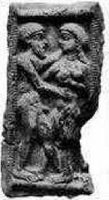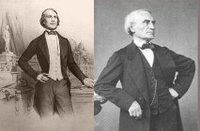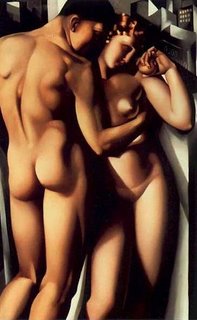 Ever since the expulsion from the Garden of Eden it seems that body covering or clothing, has become a way of controlling people; of making them feel that they belong; and a way of showing status. Well yes, and keeping warm in cooler climates.
Ever since the expulsion from the Garden of Eden it seems that body covering or clothing, has become a way of controlling people; of making them feel that they belong; and a way of showing status. Well yes, and keeping warm in cooler climates.If a school pupil fails to wear what is required then the child may well be sent home! I have always supported the idea of school uniform simply because the breaking of the rule allows individuality to be expressed, together with a totally harmless sense of rebellion. No-one is hurt or damaged by the breaking of these rules.
 Individuality expressed by 'tagging' and graffitti seems to me to be akin to a dog repeatedly pissing in order to mark out its territory and can be seen to be, in both cases, anti-social behaviour. Though I have to concede that some graffitti moves into the realms of 'art' and sometimes wit. The crude spray-can tags, however, do neither.
Individuality expressed by 'tagging' and graffitti seems to me to be akin to a dog repeatedly pissing in order to mark out its territory and can be seen to be, in both cases, anti-social behaviour. Though I have to concede that some graffitti moves into the realms of 'art' and sometimes wit. The crude spray-can tags, however, do neither. Military uniforms have a purpose of making soldiers in battle identifiable in order to reduce casualties through 'friendly fire' and what a wonderful contradiction that phrase is! I suspect that nowadays military uniforms appear much the same as each other and modern warfare is conducted, by and large, at more than arm's length. The cult of the individual in an armed force is not encouraged as, obviously, a united body of men is needed, working together in a close knit way. If you look the same as others you begin to feel that you belong. I guess that there was a time when the height of success for a school child was to get a commission in the army ~ how many public schools had within it a branch of the army as an optional, desirable, extra, and what better way to start that process than by wearing a uniform in school.
Military uniforms have a purpose of making soldiers in battle identifiable in order to reduce casualties through 'friendly fire' and what a wonderful contradiction that phrase is! I suspect that nowadays military uniforms appear much the same as each other and modern warfare is conducted, by and large, at more than arm's length. The cult of the individual in an armed force is not encouraged as, obviously, a united body of men is needed, working together in a close knit way. If you look the same as others you begin to feel that you belong. I guess that there was a time when the height of success for a school child was to get a commission in the army ~ how many public schools had within it a branch of the army as an optional, desirable, extra, and what better way to start that process than by wearing a uniform in school.The Emperor’s New Clothes, with that wonderfully whacky poking fun at the gullibility of those who wish to be seen as being in the height of fashion, is a fine example of the maddness of vanity and fashion and consumerism.
Tastes in what is acceptable clothing at any particular event must be subject to a curious set of criteria most of which are rooted in the past.
 The magician, Robert Houdin (1805-1871), was revolutionary in his time by rejecting the clothing of the traditional magician, pointed hat and long flowing cloak and choosing to wear modern court dress. This is where the idea of a magician in tailcoat originates.
The magician, Robert Houdin (1805-1871), was revolutionary in his time by rejecting the clothing of the traditional magician, pointed hat and long flowing cloak and choosing to wear modern court dress. This is where the idea of a magician in tailcoat originates.There is a London based magic club that still hankers after this kind, of what is now dated, mode of dress. They cannot accept that the young members, let's say under thirty, want to wear what youthful people wear today. They ban hats, jeans and trainers declaring, “jacket and tie preferred”.
Personally, given my background, I have no problem with jacket, or even suit, and tie. As a teacher I made it a proud boast that I could sport a different and rather stylish tie every day for several months without repeating any of them.
 So well known was this eccentricity that my last tutor group presented me with a fabulous, ‘Bart Simpson in hell’, tie when they departed the school. It is a tie of such striking design that total strangers in the street have stopped short and commented, favourably, upon it. It seems that education in schools can be more than simply coaching for the passing of exams. I always smile when I put on this tie at the memory of that group and realise that I gave them an appreciation that taste, in ties at any rate can be, not taught, but caught, through example.
So well known was this eccentricity that my last tutor group presented me with a fabulous, ‘Bart Simpson in hell’, tie when they departed the school. It is a tie of such striking design that total strangers in the street have stopped short and commented, favourably, upon it. It seems that education in schools can be more than simply coaching for the passing of exams. I always smile when I put on this tie at the memory of that group and realise that I gave them an appreciation that taste, in ties at any rate can be, not taught, but caught, through example. If the London magic club, mentioned above, abandoned its conservative dress code, or at any rate embraced ‘smart casual’ for their members, I think that these youngsters would possibly be influenced by the garb worn by those whom they admire, rather like those who wish to emulate the footballer they think is so cool, copying the kit (uniform) and sporting the same haircut as their heros.
If the London magic club, mentioned above, abandoned its conservative dress code, or at any rate embraced ‘smart casual’ for their members, I think that these youngsters would possibly be influenced by the garb worn by those whom they admire, rather like those who wish to emulate the footballer they think is so cool, copying the kit (uniform) and sporting the same haircut as their heros. The fashion industry recognises the power of celebrity in promoting fashion and appearance. No harm in this, so as long as we recognise that it all a matter of dressing-up and acting a part. The true worth of an individual is not, ultimately, to be judged by what is worn; which brings us back to the Garden of Eden; and what did those early gardeners wear?

Or . . . .

2 comments:
It's interesting that in the case of 'uniforms', kids who will often rebel against wearingthe same as everybody else, neverthelesswhen able to choose what they wear will dress exactly like their peers - in fact conform to uniformity!
PS... Your Adam & Eve (from the '30s?) are very sexy - although one wonders where their got their hair done in the Garden of Eden!
Post a Comment